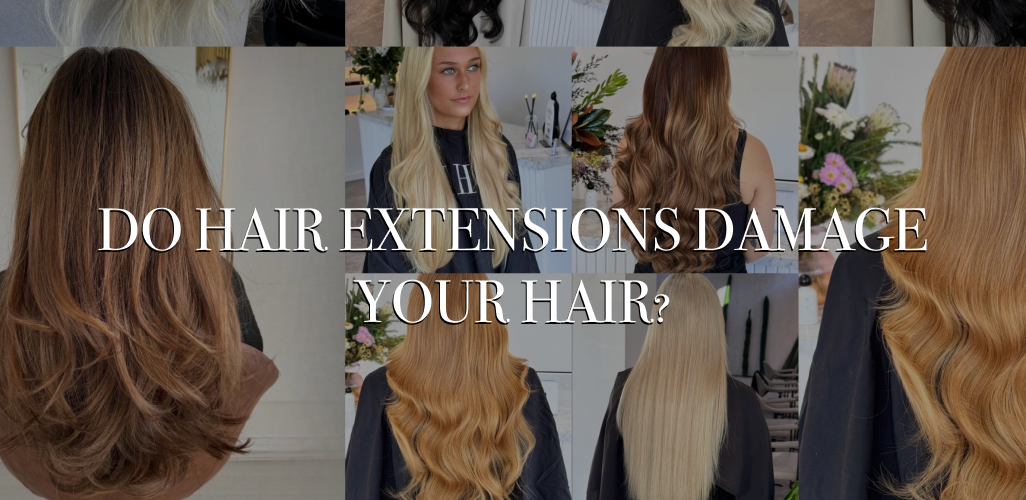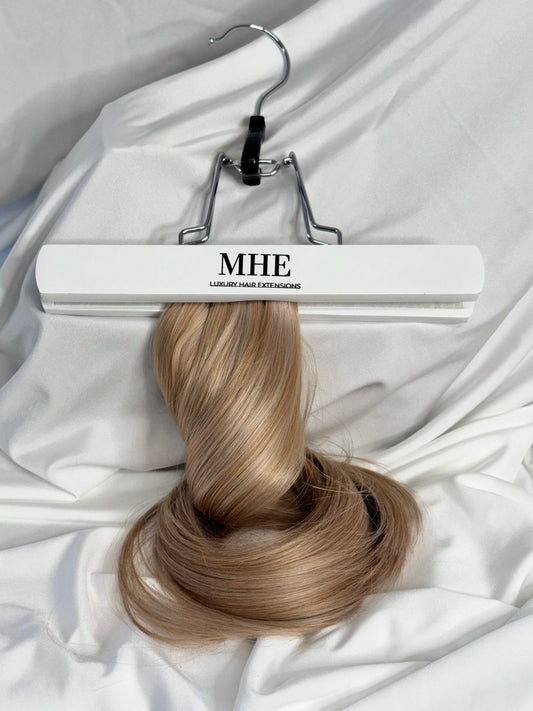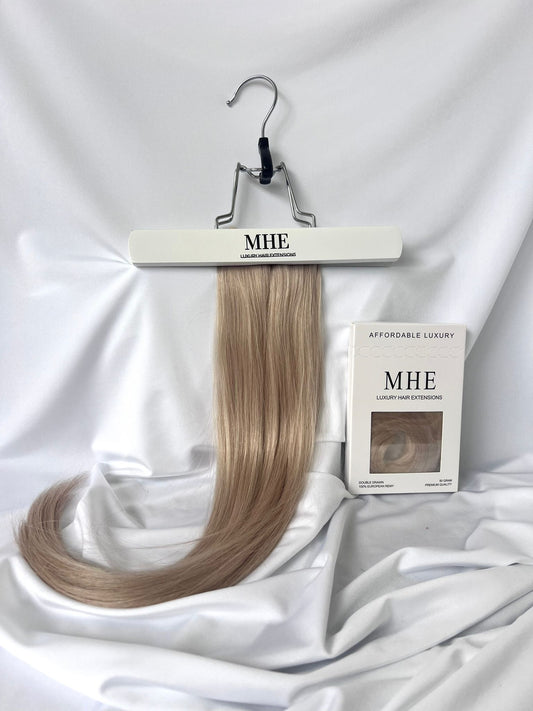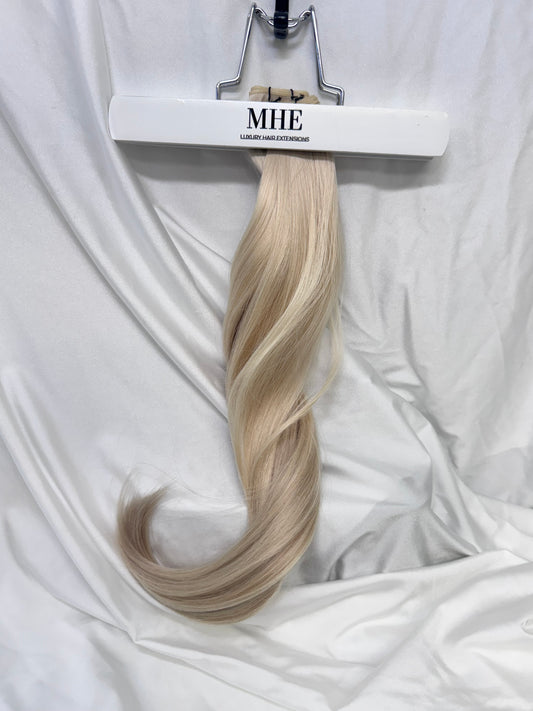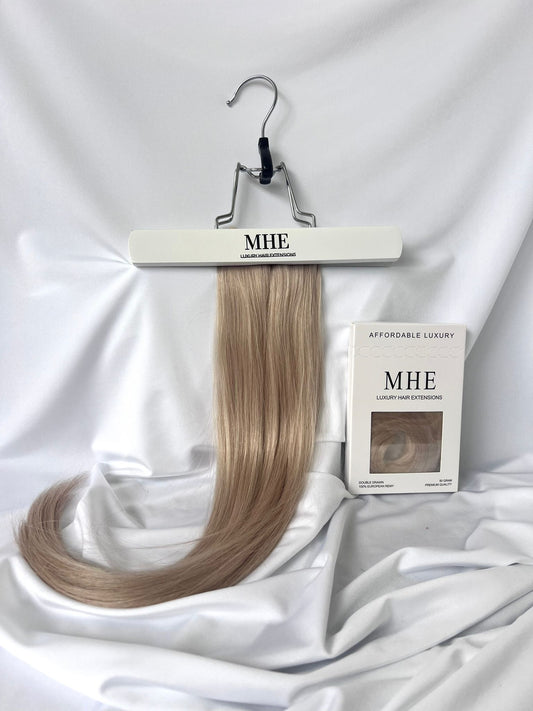Hair extensions have become a popular choice for those looking to enhance their hairstyle by adding length, volume, or even a splash of colour without the commitment of dyeing.
However, a common concern is whether hair extensions can cause damage to your natural hair.
We’re going to break down the various types of hair extensions, including clip ins, wefts & keratin bonds, their application methods, the potential impact they may have on your hair health & whether or not they can cause any damage.
Understanding Types of Hair Extensions
Before exploring the effects of hair extensions on natural hair, it's important to understand the different types available.
Hair extensions can be made from synthetic fibres or natural human hair, each offering distinct advantages and disadvantages.
Synthetic hair extensions are often more affordable and come in a wide variety of colours and styles, making them an attractive option for those looking to experiment.
However, they often don’t blend as seamlessly with natural hair and can be less versatile when it comes to styling.
On the other hand, natural human hair extensions, all of which Maiden Hair Extensions products are, provide a more realistic look and feel, allowing for heat styling and dyeing. You will often pay a slightly higher price for natural hair due to the quality difference.
Types of Hair Extensions
There are several types of hair extensions, each with unique characteristics. The most common types include clip-in, tape-in, weft (sew in), and keratin bond (fusion) extensions.
Each type has its own method of application and removal, which can influence the degree of damage they may cause.
Understanding these differences is crucial for anyone considering hair extensions, as it can help in making an informed decision based on lifestyle, hair type, desired look, and potential impact on your hair.
Clip-in Extensions: Clip ins are temporary extensions that can be easily attached and removed from your head. They are ideal for those who want to change their look without long-term commitment. Clip-ins are particularly popular among individuals who enjoy experimenting with different hairstyles or colours, like going blonde for special occasions or events.
Tape-in Extensions: These extensions are applied using adhesive tape and can last for several weeks before needing adjustments. They require professional application and removal. Tape-ins are favoured for their natural appearance and ability to lay flat against the scalp, making them less detectable.
Weft Extensions: Also known as sew in extensions, wefts are sewn into braids of natural hair. They are typically more permanent and can last for several months before needing any adjustment. This method is often chosen by those with thicker hair, as it provides a secure hold and can add significant volume.
Keratin Bond Extensions: These involve bonding individual strands of hair to natural hair using a keratin adhesive. This method can last for several months but requires professional application. Fusion or bond extensions are known for their durability and the ability to create a seamless blend with natural hair.
How Hair Extensions Are Applied
The application method of your hair extensions plays a crucial role in determining the potential for damage.
For instance, weft and keratin bond extensions can put significant stress on the hair follicles, especially if not applied correctly.
Compared to clip-in extensions, which are less likely to cause damage since they don't require any adhesive or braiding. However, even clip-ins can lead to breakage if they are not removed properly or if they are worn for extended periods without breaks.
It's important to have extensions applied by a qualified stylist who understands the best practices for minimising damage as using the proper techniques and care can significantly reduce the risk associated with hair extensions.
Additionally, regular maintenance of your extensions is essential. This includes avoiding excessive heat styling, using gentle hair care products, and ensuring that the extensions are properly cleaned and stored when not in use.
By prioritising hair health and following a hair care routine, you can enjoy the beauty and versatility of hair extensions while keeping your natural hair, and extensions, in optimal condition.
Potential Damage from Hair Extensions
While hair extensions can enhance your look, they can also pose risks to your natural hair. It’s important to understand the potential damage they can make to help you make informed decisions about your hair care & extension choice.
Traction Alopecia
One of the most significant risks associated with hair extensions is traction alopecia, a form of hair loss caused by the constant pulling on hair follicles.
This condition is more common with weft and keratin extensions, where the hair is tightly secured. Over time, this tension can lead to thinning hair or bald patches.
To mitigate the risk of traction alopecia, it's essential to avoid overly tight installations and to give your hair regular breaks between extension applications.
Consulting with a professional stylist can help ensure that the extensions are applied in a way that minimises stress on the hair.
Breakage and Split Ends
Another concern is the potential for breakage and split ends. The weight of the extensions can place additional strain on natural hair, particularly if the extensions are heavy or not properly balanced.
This can lead to weakened strands that are more susceptible to breakage.
To prevent this, you should choose extensions that are appropriate for your hair type and thickness.
Additionally, maintaining a healthy hair care routine, including regular trims and deep conditioning treatments can help keep your natural hair strong and resilient.
Heat Damage
If you use hair extensions, you may also rely on heat styling tools to blend your natural hair with the extensions.
While this can create a seamless look, excessive heat can lead to damage over time. It's crucial to use heat protectants and to limit the use of high temperatures when styling.
Alternatives to heat styling, such as braiding or using rollers, can help achieve desired looks without compromising hair health.
Embracing your natural texture can also reduce the need for heat altogether.
How to Care for Hair Extensions
Proper care of both hair extensions and natural hair is vital to minimise damage. Following a few essential guidelines can help maintain the health of your hair while enjoying the benefits of extensions.
Regular Maintenance
Regular maintenance is key to prolonging the life of hair extensions and minimising damage. This includes scheduling routine appointments with a stylist for adjustments (time between appointments will depend on your extension type) and removals.
Additionally, keeping the scalp clean and healthy is essential. Using gentle shampoos and hydrating conditioners can help prevent buildup that may weaken hair follicles. A healthy scalp promotes hair growth and reduces the risk of damage.
Gentle Styling Techniques
When styling your hair extensions, it's important to use gentle techniques. Avoid tight hairstyles that pull on the hair and consider using soft hair ties to prevent breakage. When brushing, use a wide-tooth comb to minimise tugging.
Always start detangling from the ends and work your way up to avoid unnecessary stress on the hair. This method helps prevent breakage and keeps both the extensions and natural hair looking the best.
Choosing the Right Extensions
Choosing the right type is crucial for minimising damage as each type has different risks and benefits. Factors such as your hair type, lifestyle, and desired look should all be considered when selecting extensions.
Consulting a Professional
Consulting with a professional stylist can provide valuable insights into which extensions will work best for your hair. A stylist can assess your hair type, recommend suitable options, and apply the extensions in a way that minimises damage.
Additionally, a professional can guide you on the best maintenance practices tailored to your specific extensions and hair type, ensuring that you achieve the desired look without compromising hair health.
Quality Matters
Investing in high-quality hair extensions, like Maiden Hair Extensions, is essential for both aesthetics and hair health.
Cheap or low quality extensions may not blend well and can lead to more damage due to poor materials and construction.
Opting for reputable brands that use high-quality human hair can make a significant difference in the overall experience.
High-quality extensions are often more durable, easier to style, and less likely to cause damage to natural hair.
While they may come at a slightly higher price point, the long-term benefits will often outweigh the initial investment.
Do hair extensions damage your hair?
Hair extensions can be a fantastic way to transform your look, by adding length and volume with ease.
However, it is essential to be aware of the potential risks and take proactive steps to protect your natural hair.
By understanding the different types of extensions available, their application methods, and how to care for them, you can enjoy the benefits of hair extensions while minimising their impact on your natural hair.
Ultimately, the key to healthy hair with extensions lies in informed choices, regular maintenance, and a commitment to hair care.
With the right approach, it is possible to enjoy beautiful hair extensions without compromising the health of your natural hair.

